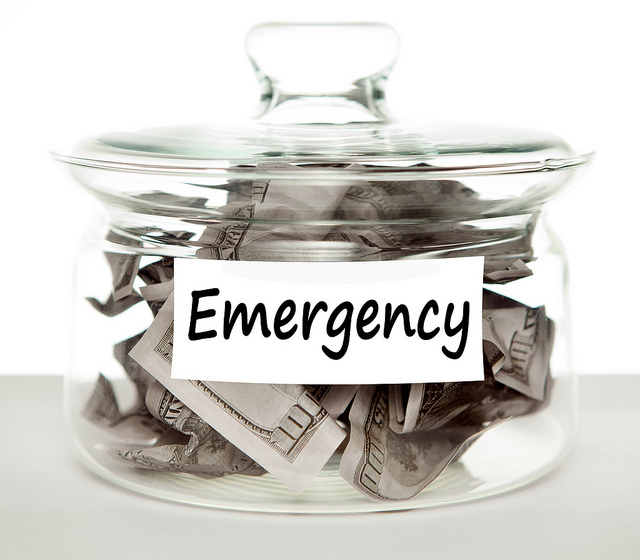What is Cash Drag?
When a portfolio holds a portion of its assets in cash for a substantial period of time, that leads to "Cash Drag." You might have sensed a negative connotation to the term cash drag, and you would be correct.
Cash drag is so named because it drags down the performance of your portfolio. That is because inflation will invariably reduce the purchasing power of cash over time. When you hold a substantial amount of cash, then that money is providing negative real returns due to inflation, but more importantly it is the opportunity cost of not investing it that is more detrimental. By that, I mean that the cash would be better invested in something that will provide positive returns, or at minimum beat inflation.
Minimizing Cash Drag
Below I have listed four strategies that I use to minimize cash drag:
This image, “Emergency Fund” is copyright (c) 2012 Tax Credits and made available under a Attribution 2.0 Generic License
1. Optimizing the Emergency Fund
The first place I think of when considering cash drag is my checking accounts. There will always be some cash in there, if only because that is where all the money flows in and out of. I also keep an emergency fund in a savings account, which is recommended for any unanticipated financial blips (e.g. medical bills, car malfunction, home repairs, etc). However, there is always a question of how much cash you really need to keep in an emergency fund, which I will discuss below.
Many financial advisors recommend keeping at least 3-6 months, some up to a year, of cash equal to your expenses. This could be a huge amount of cash potentially just sitting in your bank account, declining at a rate of 2-3% per year due to inflation.
Do you need $50k immediately available because you lost your job? I doubt it! In reality, you probably need a few thousand dollars now, a few thousand the next month, and so forth. I have heard Paula Pant @AffordAnything support a "tiered emergency fund" in one of her podcasts, which is very similar to my strategy.
I hold a relatively small amount of money in cash, equal to maybe 2-3 months of expenses.
I then keep an "emergency fund portfolio" that is partly invested in a low volatility index fund, in my case the Vanguard Bond Index fund. This will cover an additional 3-4 months of expenses.
Finally, the remainder is invested in a large cap domestic stock index fund. These are kept in a Vanguard taxable brokerage account. This can cover at least another 6 months of expenses. I have not designated this portfolio as part of the emergency fund per se, because this taxable brokerage account receives ongoing automated investments after all of my retirement accounts are maxed out.
The reason I have most of my emergency fund invested is once again to reduce cash drag. If the money is not needed, it will continue to grow and likely beat inflation. The money can be mobilized very easily. If the market is declining, then the bond index fund will provide some protection from that, and can be liquidated first while the stocks are recovering. If the stocks have appreciated a lot, you can use those first. This is a concept I learned from this Betterment.com article.
To summarize the article, it recommends against keeping 100% of your safety net in cash but, rather, that you keep 130% of your safety net in a moderate risk portfolio. Their graph is totally awesome in depicting the account value of historical 5 year periods of a portfolio invested in 40% S&P 500 and 60% 5-year treasury bills. Spoiler alert: all of them will at least maintain your 100% safety net, but there is a very good chance of growth.
2. Buying Index Funds Instead of Mutual Funds
When you invest in mutual funds that are actively managed, the manager of the fund has control over what is being bought and sold within the fund. If, for instance, the fund manager sold a holding and kept it as cash for several days before buying something else, that is considered cash drag. Repeat this over and over and it could be substantial. Continued exposure to the market more often yields higher performance than trying to time the market, especially when you consider capital gains taxes.
3. Automating Investments
This is not the same as dollar cost averaging, which I had discussed in this article. With automated investments, you automatically direct a portion of your income to to an investment (i.e. an index fund), or you time the contributions to happen on or shortly after each paycheck. By timing this with your paychecks, you are immediately investing the cash you receive as income, so there is minimal time for cash drag.
This image, “Water drips (14)” is copyright (c) 2014 Chris W. and made available under a Attribution 2.0 Generic License
4. DRIP
Periodically, your investments will yield dividends that are paid to you in cash. Many banks will allow you to automatically reinvest these dividends into the same investment. This is called a DRIP, or Dividend ReInvestment Plan. This happens automatically and immediately when the dividend is paid, so there is zero cash drag.
Summary
Cash drag happens when you hold too much cash for too long, which leads to negative returns over time due to inflation, but also has a high opportunity cost when the cash could instead be invested in other assets.



